Thermal conductivity of building materials: what does the indicator mean + table of values
The construction business involves the use of any suitable materials. The main criteria are safety for life and health, thermal conductivity, reliability. The following are price, aesthetics, versatility, etc.
Consider one of the most important characteristics of building materials - the coefficient of thermal conductivity, since it is precisely on this property that, for example, depends on the level of comfort in the house.
The content of the article:
What is KTP building material?
Theoretically, and practically the same, with building materials, as a rule, two surfaces are created - external and internal. From the point of view of physics, a warm region always tends to a cold region.
In relation to building material, heat will tend from one surface (warmer) to another surface (less warm). Here, in fact, the ability of a material with respect to such a transition is called the thermal conductivity coefficient or, in the abbreviation, KTP.
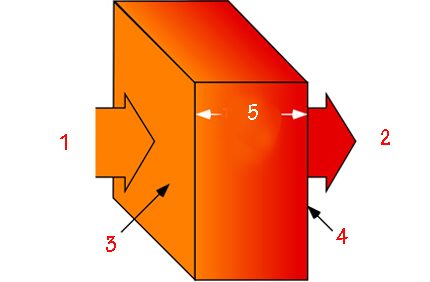
The characteristic of a transformer substation is usually based on tests, when an experimental specimen of 100x100 cm is taken and the thermal effect is applied to it, taking into account a temperature difference of two surfaces of 1 degree. The exposure time is 1 hour.
Accordingly, thermal conductivity is measured in watts per meter per degree (W / m ° C). The coefficient is indicated by the Greek symbol λ.
By default, the thermal conductivity of various materials for construction with a value of less than 0.175 W / m ° C, equates these materials to the category of insulating materials.
Modern production has mastered the technology of manufacturing building materials, the level of KTP which is less than 0.05 W / m ° C.Thanks to such products, it is possible to achieve a pronounced economic effect in terms of energy resources consumption.
Influence of factors on the level of thermal conductivity
Each individual building material has a specific structure and has a kind of physical condition.
The basis of this are:
- dimension of crystals of the structure;
- phase state of the substance;
- degree of crystallization;
- anisotropy of the thermal conductivity of crystals;
- volume of porosity and structure;
- heat flow direction.
All these are factors of influence. The chemical composition and impurities also have a certain effect on the level of KTP. The amount of impurities, as practice has shown, has a particularly expressive effect on the level of thermal conductivity of crystalline components.
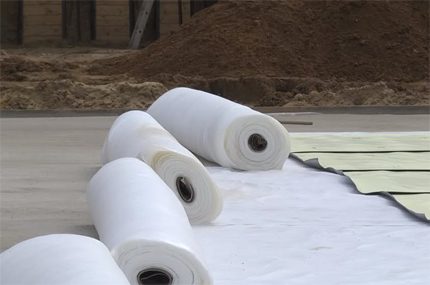
In turn, the KTP is influenced by the operating conditions of the building material - temperature, pressure, humidity, etc.
Building materials with minimal KTP
According to studies, the minimum value of thermal conductivity (about 0.023 W / m ° C) has dry air.
From the point of view of the use of dry air in the structure of a building material, a design is needed where dry air resides inside numerous enclosed spaces of small volume. Structurally, such a configuration is represented in the image of numerous pores within the structure.
Hence the logical conclusion: building materials, the internal structure of which is a porous formation, must have a low level of KTP.
Moreover, depending on the maximum permissible porosity of the material, the value of thermal conductivity approaches the value of the thermal transfer coefficient of dry air.

In modern production, several technologies are used to obtain the porosity of the building material.
In particular, the following technologies are used:
- foaming;
- gas formation;
- water supply;
- swelling;
- introduction of additives;
- create fiber frames.
It should be noted: the coefficient of thermal conductivity is directly related to such properties as density, heat capacity, thermal conductivity.
The value of thermal conductivity can be calculated by the formula:
λ = Q / S * (T1-T2) * t,
Where:
- Q - The amount of heat;
- S - material thickness;
- T1, T2 - temperature on both sides of the material;
- t - time.
The average density and thermal conductivity are inversely proportional to the porosity. Therefore, based on the density of the structure of the building material, the dependence of thermal conductivity on it can be calculated as follows:
λ = 1.16 √ 0.0196 + 0.22d2 – 0,16,
Where: d Is the density value. This is the formula of V.P. Nekrasov, demonstrating the influence of the density of a particular material on the value of its KTP.
The effect of moisture on the thermal conductivity of building materials
Again, judging by examples of the use of building materials in practice, the negative effect of moisture on the construction materials of the building materials is revealed. It is noticed - the more moisture the building material is subjected to, the higher the value of the KTP becomes.
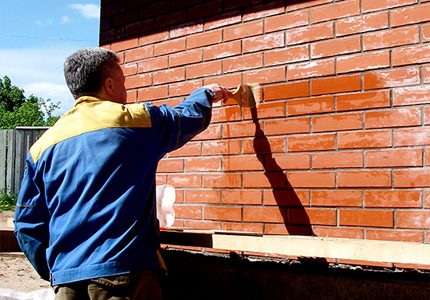
Justifying such a moment is not difficult. The effect of moisture on the structure of the building material is accompanied by humidification of the air in the pores and partial replacement of the air.
Given that the parameter of the thermal conductivity coefficient for water is 0.58 W / m ° C, a significant increase in the thermal conductivity of the material becomes clear.
It should also be noted a more negative effect, when water entering the porous structure is additionally frozen - it turns into ice.
Accordingly, it is easy to calculate an even greater increase in thermal conductivity, taking into account the parameters of the KTP of ice, equal to the value of 2.3 W / m ° C. An increase of about four times to the thermal conductivity of water.
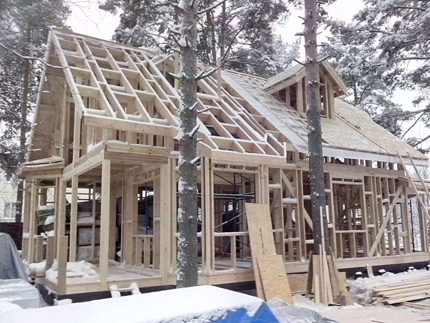
From this, the construction requirements regarding the protection of insulating building materials from moisture penetration become apparent. After all, the level of thermal conductivity increases in direct proportion to quantitative humidity.
No less significant is another point - the opposite, when the structure of the building material is subjected to significant heating. Excessively high temperature also provokes an increase in thermal conductivity.
This happens due to an increase in the kinematic energy of the molecules that make up the structural basis of the building material.
True, there is a class of materials, the structure of which, on the contrary, acquires the best properties of thermal conductivity in the regime of strong heating. One such material is metal.
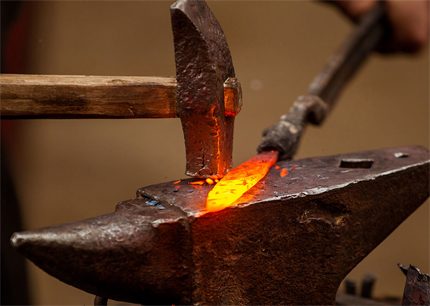
Coefficient determination methods
Different methods are used in this direction, but in fact all measurement technologies are combined by two groups of methods:
- Stationary measurement mode.
- Non-stationary measurement mode.
The stationary technique implies working with parameters that are unchanged over time or vary insignificantly. This technology, judging by practical applications, allows counting on more accurate results of KTP.
The actions aimed at measuring thermal conductivity, the stationary method can be carried out in a wide temperature range - 20 - 700 ° C. But at the same time, stationary technology is considered time-consuming and complex technique, requiring a large amount of time for execution.
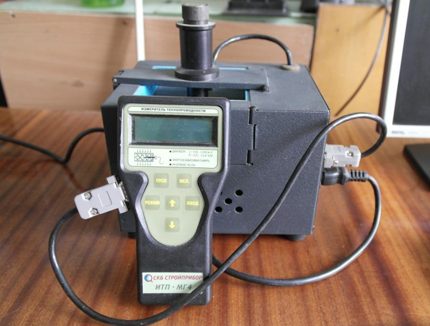
Another measurement technology is non-stationary, it seems more simplified, requiring 10 to 30 minutes to complete the work. However, in this case, the temperature range is significantly limited. Nevertheless, the technique has found wide application in the manufacturing sector.
Table of thermal conductivity of building materials
It makes no sense to measure many existing and widely used building materials.
All these products, as a rule, have been tested repeatedly, on the basis of which a table of thermal conductivity of building materials has been compiled, which includes almost all the materials necessary for the construction site.
One of the options for such a table is presented below, where KTP is the thermal conductivity coefficient:
| Material (building material) | Density, m3 | KTP dry, W / mºC | % humid_1 | % humid_2 | KTP at damp_1, W / m ºC | KTP at damp_2, W / m ºC | |||
| Roofing bitumen | 1400 | 0,27 | 0 | 0 | 0,27 | 0,27 | |||
| Roofing bitumen | 1000 | 0,17 | 0 | 0 | 0,17 | 0,17 | |||
| Roofing slate | 1800 | 0,35 | 2 | 3 | 0,47 | 0,52 | |||
| Roofing slate | 1600 | 0,23 | 2 | 3 | 0,35 | 0,41 | |||
| Roofing bitumen | 1200 | 0,22 | 0 | 0 | 0,22 | 0,22 | |||
| Asbestos cement sheet | 1800 | 0,35 | 2 | 3 | 0,47 | 0,52 | |||
| Asbestos cement sheet | 1600 | 0,23 | 2 | 3 | 0,35 | 0,41 | |||
| Asphalt concrete | 2100 | 1,05 | 0 | 0 | 1,05 | 1,05 | |||
| Building Roofing | 600 | 0,17 | 0 | 0 | 0,17 | 0,17 | |||
| Concrete (on a gravel pad) | 1600 | 0,46 | 4 | 6 | 0,46 | 0,55 | |||
| Concrete (on a slag cushion) | 1800 | 0,46 | 4 | 6 | 0,56 | 0,67 | |||
| Concrete (on gravel) | 2400 | 1,51 | 2 | 3 | 1,74 | 1,86 | |||
| Concrete (on a sand cushion) | 1000 | 0,28 | 9 | 13 | 0,35 | 0,41 | |||
| Concrete (porous structure) | 1000 | 0,29 | 10 | 15 | 0,41 | 0,47 | |||
| Concrete (solid structure) | 2500 | 1,89 | 2 | 3 | 1,92 | 2,04 | |||
| Pumice concrete | 1600 | 0,52 | 4 | 6 | 0,62 | 0,68 | |||
| Construction bitumen | 1400 | 0,27 | 0 | 0 | 0,27 | 0,27 | |||
| Construction bitumen | 1200 | 0,22 | 0 | 0 | 0,22 | 0,22 | |||
| Lightweight mineral wool | 50 | 0,048 | 2 | 5 | 0,052 | 0,06 | |||
| Mineral wool heavy | 125 | 0,056 | 2 | 5 | 0,064 | 0,07 | |||
| Mineral wool | 75 | 0,052 | 2 | 5 | 0,06 | 0,064 | |||
| Vermiculite leaf | 200 | 0,065 | 1 | 3 | 0,08 | 0,095 | |||
| Vermiculite leaf | 150 | 0,060 | 1 | 3 | 0,074 | 0,098 | |||
| Gas-foam-ash concrete | 800 | 0,17 | 15 | 22 | 0,35 | 0,41 | |||
| Gas-foam-ash concrete | 1000 | 0,23 | 15 | 22 | 0,44 | 0,50 | |||
| Gas-foam-ash concrete | 1200 | 0,29 | 15 | 22 | 0,52 | 0,58 | |||
| Gas foam concrete (foam silicate) | 300 | 0,08 | 8 | 12 | 0,11 | 0,13 | |||
| Gas foam concrete (foam silicate) | 400 | 0,11 | 8 | 12 | 0,14 | 0,15 | |||
| Gas foam concrete (foam silicate) | 600 | 0,14 | 8 | 12 | 0,22 | 0,26 | |||
| Gas foam concrete (foam silicate) | 800 | 0,21 | 10 | 15 | 0,33 | 0,37 | |||
| Gas foam concrete (foam silicate) | 1000 | 0,29 | 10 | 15 | 0,41 | 0,47 | |||
| Gypsum slab | 1200 | 0,35 | 4 | 6 | 0,41 | 0,46 | |||
| Expanded clay gravel | 600 | 2,14 | 2 | 3 | 0,21 | 0,23 | |||
| Expanded clay gravel | 800 | 0,18 | 2 | 3 | 0,21 | 0,23 | |||
| Granite (basalt) | 2800 | 3,49 | 0 | 0 | 3,49 | 3,49 | |||
| Expanded clay gravel | 400 | 0,12 | 2 | 3 | 0,13 | 0,14 | |||
| Expanded clay gravel | 300 | 0,108 | 2 | 3 | 0,12 | 0,13 | |||
| Expanded clay gravel | 200 | 0,099 | 2 | 3 | 0,11 | 0,12 | |||
| Shungizite gravel | 800 | 0,16 | 2 | 4 | 0,20 | 0,23 | |||
| Shungizite gravel | 600 | 0,13 | 2 | 4 | 0,16 | 0,20 | |||
| Shungizite gravel | 400 | 0,11 | 2 | 4 | 0,13 | 0,14 | |||
| Wood pine transverse fiber | 500 | 0,09 | 15 | 20 | 0,14 | 0,18 | |||
| Glued plywood | 600 | 0,12 | 10 | 13 | 0,15 | 0,18 | |||
| Pine tree along the fibers | 500 | 0,18 | 15 | 20 | 0,29 | 0,35 | |||
| Oak Tree Across the Fibers | 700 | 0,23 | 10 | 15 | 0,18 | 0,23 | |||
| Duralumin Metal | 2600 | 221 | 0 | 0 | 221 | 221 | |||
| Reinforced concrete | 2500 | 1,69 | 2 | 3 | 1,92 | 2,04 | |||
| Tuff concrete | 1600 | 0,52 | 7 | 10 | 0,7 | 0,81 | |||
| Limestone | 2000 | 0,93 | 2 | 3 | 1,16 | 1,28 | |||
| Mortar with sand | 1700 | 0,52 | 2 | 4 | 0,70 | 0,87 | |||
| Sand for construction work | 1600 | 0,035 | 1 | 2 | 0,47 | 0,58 | |||
| Tuff concrete | 1800 | 0,64 | 7 | 10 | 0,87 | 0,99 | |||
| Facing cardboard | 1000 | 0,18 | 5 | 10 | 0,21 | 0,23 | |||
| Laminated board | 650 | 0,13 | 6 | 12 | 0,15 | 0,18 | |||
| Foam rubber | 60-95 | 0,034 | 5 | 15 | 0,04 | 0,054 | |||
| Expanded clay | 1400 | 0,47 | 5 | 10 | 0,56 | 0,65 | |||
| Expanded clay | 1600 | 0,58 | 5 | 10 | 0,67 | 0,78 | |||
| Expanded clay | 1800 | 0,86 | 5 | 10 | 0,80 | 0,92 | |||
| Brick (hollow) | 1400 | 0,41 | 1 | 2 | 0,52 | 0,58 | |||
| Brick (ceramic) | 1600 | 0,47 | 1 | 2 | 0,58 | 0,64 | |||
| Tow construction | 150 | 0,05 | 7 | 12 | 0,06 | 0,07 | |||
| Brick (silicate) | 1500 | 0,64 | 2 | 4 | 0,7 | 0,81 | |||
| Brick (solid) | 1800 | 0,88 | 1 | 2 | 0,7 | 0,81 | |||
| Brick (slag) | 1700 | 0,52 | 1,5 | 3 | 0,64 | 0,76 | |||
| Brick (clay) | 1600 | 0,47 | 2 | 4 | 0,58 | 0,7 | |||
| Brick (trepelny) | 1200 | 0,35 | 2 | 4 | 0,47 | 0,52 | |||
| Metal copper | 8500 | 407 | 0 | 0 | 407 | 407 | |||
| Dry plaster (sheet) | 1050 | 0,15 | 4 | 6 | 0,34 | 0,36 | |||
| Mineral wool slabs | 350 | 0,091 | 2 | 5 | 0,09 | 0,11 | |||
| Mineral wool slabs | 300 | 0,070 | 2 | 5 | 0,087 | 0,09 | |||
| Mineral wool slabs | 200 | 0,070 | 2 | 5 | 0,076 | 0,08 | |||
| Mineral wool slabs | 100 | 0,056 | 2 | 5 | 0,06 | 0,07 | |||
| PVC linoleum | 1800 | 0,38 | 0 | 0 | 0,38 | 0,38 | |||
| Foam concrete | 1000 | 0,29 | 8 | 12 | 0,38 | 0,43 | |||
| Foam concrete | 800 | 0,21 | 8 | 12 | 0,33 | 0,37 | |||
| Foam concrete | 600 | 0,14 | 8 | 12 | 0,22 | 0,26 | |||
| Foam concrete | 400 | 0,11 | 6 | 12 | 0,14 | 0,15 | |||
| Foam concrete on limestone | 1000 | 0,31 | 12 | 18 | 0,48 | 0,55 | |||
| Foam concrete on cement | 1200 | 0,37 | 15 | 22 | 0,60 | 0,66 | |||
| Expanded polystyrene (PSB-S25) | 15 – 25 | 0,029 – 0,033 | 2 | 10 | 0,035 – 0,052 | 0,040 – 0,059 | |||
| Expanded polystyrene (PSB-S35) | 25 – 35 | 0,036 – 0,041 | 2 | 20 | 0,034 | 0,039 | |||
| Polyurethane foam sheet | 80 | 0,041 | 2 | 5 | 0,05 | 0,05 | |||
| Polyurethane foam panel | 60 | 0,035 | 2 | 5 | 0,41 | 0,41 | |||
| Lightweight foam glass | 200 | 0,07 | 1 | 2 | 0,08 | 0,09 | |||
| Weighted foam glass | 400 | 0,11 | 1 | 2 | 0,12 | 0,14 | |||
| Pergamine | 600 | 0,17 | 0 | 0 | 0,17 | 0,17 | |||
| Perlite | 400 | 0,111 | 1 | 2 | 0,12 | 0,13 | |||
| Pearlitic cement slab | 200 | 0,041 | 2 | 3 | 0,052 | 0,06 | |||
| Marble | 2800 | 2,91 | 0 | 0 | 2,91 | 2,91 | |||
| Tuff | 2000 | 0,76 | 3 | 5 | 0,93 | 1,05 | |||
| Ash Gravel Concrete | 1400 | 0,47 | 5 | 8 | 0,52 | 0,58 | |||
| Plate of fiberboard (chipboard) | 200 | 0,06 | 10 | 12 | 0,07 | 0,08 | |||
| Plate of fiberboard (chipboard) | 400 | 0,08 | 10 | 12 | 0,11 | 0,13 | |||
| Plate of fiberboard (chipboard) | 600 | 0,11 | 10 | 12 | 0,13 | 0,16 | |||
| Plate of fiberboard (chipboard) | 800 | 0,13 | 10 | 12 | 0,19 | 0,23 | |||
| Plate of fiberboard (chipboard) | 1000 | 0,15 | 10 | 12 | 0,23 | 0,29 | |||
| Portland cement polystyrene concrete | 600 | 0,14 | 4 | 8 | 0,17 | 0,20 | |||
| Vermiculite concrete | 800 | 0,21 | 8 | 13 | 0,23 | 0,26 | |||
| Vermiculite concrete | 600 | 0,14 | 8 | 13 | 0,16 | 0,17 | |||
| Vermiculite concrete | 400 | 0,09 | 8 | 13 | 0,11 | 0,13 | |||
| Vermiculite concrete | 300 | 0,08 | 8 | 13 | 0,09 | 0,11 | |||
| Ruberoid | 600 | 0,17 | 0 | 0 | 0,17 | 0,17 | |||
| Fiberboard plate | 800 | 0,16 | 10 | 15 | 0,24 | 0,30 | |||
| Metal steel | 7850 | 58 | 0 | 0 | 58 | 58 | |||
| Glass | 2500 | 0,76 | 0 | 0 | 0,76 | 0,76 | |||
| Glass wool | 50 | 0,048 | 2 | 5 | 0,052 | 0,06 | |||
| Fiberglass | 50 | 0,056 | 2 | 5 | 0,06 | 0,064 | |||
| Fiberboard plate | 600 | 0,12 | 10 | 15 | 0,18 | 0,23 | |||
| Fiberboard plate | 400 | 0,08 | 10 | 15 | 0,13 | 0,16 | |||
| Fiberboard plate | 300 | 0,07 | 10 | 15 | 0,09 | 0,14 | |||
| Glued plywood | 600 | 0,12 | 10 | 13 | 0,15 | 0,18 | |||
| Reed plate | 300 | 0,07 | 10 | 15 | 0,09 | 0,14 | |||
| Cement-sand mortar | 1800 | 0,58 | 2 | 4 | 0,76 | 0,93 | |||
| Metal cast iron | 7200 | 50 | 0 | 0 | 50 | 50 | |||
| Cement-slag mortar | 1400 | 0,41 | 2 | 4 | 0,52 | 0,64 | |||
| Complex sand solution | 1700 | 0,52 | 2 | 4 | 0,70 | 0,87 | |||
| Dry plaster | 800 | 0,15 | 4 | 6 | 0,19 | 0,21 | |||
| Reed plate | 200 | 0,06 | 10 | 15 | 0,07 | 0,09 | |||
| Cement plaster | 1050 | 0,15 | 4 | 6 | 0,34 | 0,36 | |||
| Peat plate | 300 | 0,064 | 15 | 20 | 0,07 | 0,08 | |||
| Peat plate | 200 | 0,052 | 15 | 20 | 0,06 | 0,064 | |||
We also recommend reading our other articles, where we talk about how to choose the right insulation:
- Insulation for the attic roof.
- Materials for warming the house from the inside.
- Insulation for the ceiling.
- Materials for external thermal insulation.
- Insulation for the floor in a wooden house.
Conclusions and useful video on the topic
The video is thematically directed, which explains in sufficient detail what KTP is and “what it is eaten with”. After reviewing the material presented in the video, there are high chances to become a professional builder.
The obvious point is that a potential builder needs to know about thermal conductivity and its dependence on various factors. This knowledge will help to build not just high quality, but with a high degree of reliability and durability of the object. Using the coefficient in essence is a real saving of money, for example, in paying for the same utility services.
If you have questions or have valuable information on the topic of the article, please leave your comments in the box below.

 How much does it cost to connect gas to a private house: the price of organizing gas supply
How much does it cost to connect gas to a private house: the price of organizing gas supply  The best washing machines with dryer: model rating and customer tips
The best washing machines with dryer: model rating and customer tips  What is the color temperature of light and the nuances of choosing the temperature of the lamps to suit your needs
What is the color temperature of light and the nuances of choosing the temperature of the lamps to suit your needs  Replacement of a geyser in an apartment: replacement paperwork + basic norms and requirements
Replacement of a geyser in an apartment: replacement paperwork + basic norms and requirements
Wow, what an old-slate, it turns out, reliable in this regard. I already thought cardboard removes more heat. Still, there is nothing better than concrete, as for me. Maximum heat and comfort, do not care about humidity and other negative factors. And if concrete + slate, then in general fire 🙂 just torment it, you’re tormented by it, now they make it so dull in quality ..
Our roof is covered with slate. In summer, it is never hot at home. It looks unpretentious, but better than metal or roofing iron. But we did not do it because of the numbers. In construction, you need to use a proven methodology and be able to choose the best in the markets with a small budget. Well, and evaluate the operating conditions of housing.Sochi residents do not need to build houses ready for forty degree frosts. It will be in vain wasted funds.